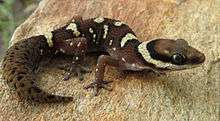Pachydactylus
Pachydactylus is a genus of insectivorous geckos, lizards in the family Gekkonidae. The genus is endemic to Africa, and member species are commonly known as thick-toed geckos.
| Thick-toed geckos | |
|---|---|
 | |
| P. oshaughnessyi at Lusaka, Zambia | |
| Scientific classification | |
| Kingdom: | Animalia |
| Phylum: | Chordata |
| Class: | Reptilia |
| Order: | Squamata |
| Family: | Gekkonidae |
| Subfamily: | Uroplatinae |
| Genus: | Pachydactylus Wiegmann, 1834[1] |
| Synonyms | |
Description
The genus Pachydactylus is characterised by dilated toe tips, usually with undivided scansors. Body scales are small, granular and non-overlapping, with scattered, large keeled tubercles.
Habitat
Pachydactylus species live in a diverse range of habitats.
Diet
Lizards of the genus Pachydactylus feed mainly on arthropods.
Geographic range
The geographic range of the genus Pachydactylus is centred on Southern Africa, with some species reaching East Africa, the northernmost limit of their distribution.
Species
There are 57 species that are recognized as being valid:[4]
- Pachydactylus acuminatus V. FitzSimons, 1941
- Pachydactylus affinis Boulenger, 1896 – Transvaal thick-toed gecko
- Pachydactylus amoenus F. Werner, 1910
- Pachydactylus angolensis Loveridge, 1944 - Angola large-scaled gecko, Angolan thick-toed gecko
- Pachydactylus atorquatus Bauer, Barts & Hulbert, 2006
- Pachydactylus austeni Hewitt, 1923 – Austen's thick-toed gecko
- Pachydactylus barnardi V. FitzSimons, 1941 – Barnard's thick-toed gecko[5]
- Pachydactylus bicolor Hewitt, 1926 – velvety thick-toed gecko
- Pachydactylus boehmei Bauer, 2010
- Pachydactylus capensis (A. Smith, 1846) – Cape thick-toed gecko
- Pachydactylus caraculicus V. FitzSimons, 1959 – Angola banded thick-toed gecko
- Pachydactylus carinatus Bauer, Lamb & Branch, 2006
- Pachydactylus etultra Branch, Bauer, Jackman & Heinicke, 2011
- Pachydactylus fasciatus Boulenger, 1888 – banded thick-toed gecko
- Pachydactylus formosus A. Smith, 1849 – Smith's thick-toed gecko
- Pachydactylus gaiasensis Steyn & J. Mitchell, 1967 – Brandberg thick-toed gecko
- Pachydactylus geitje (Sparrman, 1778) – ocellated thick-toed gecko
- Pachydactylus griffini Bauer, Lamb & Branch, 2006
- Pachydactylus haackei Branch, Bauer & Good, 1996 – Haacke's thick-toed gecko
- Pachydactylus katanganus de Witte, 1953
- Pachydactylus kladaroderma Branch, Bauer & Good, 1996 – thin-skinned thick-toed gecko
- Pachydactylus kobosensis V. FitzSimons, 1938
- Pachydactylus kochii (V. FitzSimons, 1959)
- Pachydactylus labialis V. FitzSimons, 1938 – Calvinia thick-toed gecko
- Pachydactylus latirostris Hewitt, 1923 – quartz gecko
- Pachydactylus macrolepis FitzSimons, 1939 – large-scaled banded gecko
- Pachydactylus maculatus Gray, 1845 – spotted thick-toed gecko
- Pachydactylus maraisi Heinicke, Adderly, Bauer & Jackman, 2011
- Pachydactylus mariquensis A. Smith, 1849 – Marico thick-toed gecko
- Pachydactylus mclachlani Bauer, Lamb & Branch, 2006
- Pachydactylus monicae Bauer, Lamb & Branch, 2006
- Pachydactylus montanus Methuen & Hewitt, 1914
- Pachydactylus namaquensis (Sclater, 1898) – Namaqua thick-toed gecko
- Pachydactylus oculatus Hewitt, 1927 – golden spotted thick-toed gecko
- Pachydactylus oreophilus McLachlan & Spence, 1967 – Kaokoveld thick-toed gecko
- Pachydactylus oshaughnessyi Boulenger, 1885
- Pachydactylus otaviensis Bauer, Lamb & Branch, 2006
- Pachydactylus parascutatus Bauer, Lamb & Branch, 2002
- Pachydactylus punctatus W. Peters, 1854 – speckled thick-toed gecko
- Pachydactylus purcelli Boulenger, 1910
- Pachydactylus rangei (Andersson, 1908) – Namib sand gecko
- Pachydactylus reconditus Bauer, Lamb & Branch, 2006
- Pachydactylus robertsi V. FitzSimons, 1938
- Pachydactylus rugosus A. Smith, 1849 – rough thick-toed gecko
- Pachydactylus sansteynae Steyn & Mitchell, 1967 – San Steyn's thick-toed gecko
- Pachydactylus scherzi Mertens, 1954 – Sherz's thick-toed gecko
- Pachydactylus scutatus Hewitt, 1927 – large-scaled thick-toed gecko
- Pachydactylus serval F. Werner, 1910 – western spotted thick-toed gecko
- Pachydactylus tigrinus Van Dam, 1921 – tiger thick-toed gecko
- Pachydactylus tsodiloensis Haacke, 1966 – Tsodilo thick-toed gecko
- Pachydactylus vansoni V. FitzSimons, 1933 – Van Son's thick-toed gecko
- Pachydactylus vanzyli (Steyn & Haacke, 1966)
- Pachydactylus visseri Bauer, Lamb & Branch, 2006
- Pachydactylus wahlbergii W. Peters, 1869
- Pachydactylus waterbergensis Bauer, Lamb & Branch, 2003
- Pachydactylus weberi Roux, 1907 – Weber's thick-toed gecko[5]
- Pachydactylus werneri Hewitt, 1935
Nota bene: A binomial authority in parentheses indicates that the species was originally described in a genus other than Pachydactylus.
References
- "Pachydactylus ". ITIS (Integrated Taxonomic Information System). www.itis.gov.
- Species Pachydactylus wahlbergii at The Reptile Database . ("Colopus wahlbergii PETERS 1869 is the type species of the genus Colopus.")
- Species Pachydactylus rangei at The Reptile Database . ("Palmatogecko rangei [ANDERSSON 1908] is the type species of the genus Palmatogecko.")
- "Pachydactylus ". The Reptile Database. www.reptile-database.org.
- Beolens, Bo; Watkins, Michael; Grayson, Michael (2011). The Eponym Dictionary of Reptiles. Baltimore: Johns Hopkins University Press. xiii + 296 pp. ISBN 978-1-4214-0135-5. (Pachydactylus barnardi, p. 17; P. weberi, p. 280).
Further reading
- Bauer AM, Lamb T, Branch WR (2006). "A Revision of the Pachydactylus serval and P. weberi Groups (Reptilia: Gekkota: Gekkonidae) of Southern Africa, with the Description of Eight New Species". Proc. California Acad. Sci. 57 (23): 595–709.
- Boulenger GA (1885). Catalogue of the Lizards in the British Museum (Natural History). Second Edition. Volume I. Geckonidæ ... London: Trustees of the British Museum (Natural History). (Taylor and Francis, printers). xii + 436 pp. + Plates I-XXXi. (Genus Pachydactylus, p. 200).
- Branch, Bill (2004). Field Guide to Snakes and other Reptiles of Southern Africa. Third Revised edition, Second impression. Sanibel Island, Florida: Ralph Curtis Books. 399 pp. ISBN 0-88359-042-5. (Genus Pachydactylus, pp. 249–250).
- Wiegmann AFA (1834). Herpetologia Mexicana, seu descriptio amphibiorum Novae Hispaniae, quae itineribus comitis Sack, Ferdinandi Deppe et Chr. Guil. Schiede in Museum Zoologicum Berolinense pervenerunt. Pars prima, saurorum species amplectens. Adiecto systematis saurorum prodromo, additisque multis in hunc amphibiorum ordinem observationibus. Berlin: C.G. Lüderitz. vi + 54 pp. + Plates I-X. (Pachydactylus, new genus, p. 19). (in Latin).